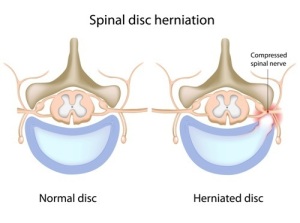One observation regarding disc herniation treatment suggestions by neurosurgeons is that about 97% of disc herniations in the lower back or cervical spine do not need surgery and can be managed conservatively.
However, about 20 % end up with surgery, which often leads to unnecessary back pain from scar tissue.
Neurological examination looking for nerve impingement
The decision whether or not back surgery is necessary should be based on a neurological exam where the examiner determines whether or not pinched nerves are present. With a lower back disc herniation impinging the sciatic nerve (S1 nerve root compression there is sciatica pain with pain radiating beyond the level of the knee into the lower leg and foot and a loss of feeling of the sole of the foot on the affected side.
Nerve root impingement
Also, that foot cannot be lifted, in other words a drop foot has developed. Associated with this is a weak or missing Achilles reflex. With the lower cervical spine the physician determines whether or not similar neurological signs are present with radiating pain and numbness of hands. In addition to these clinical signs MRI scans will confirm the clinical finding.
It is my experience that those cases where the surgical indication was not clear-cut, turn out to be disastrous later. Both the neurosurgeon and the patient are served well, if only those cases come to surgery that is expected to get better with surgery.
Discectomy may be needed
If there is no improvement within 2 months, and neurological signs of nerve root compression do not reverse themselves, surgery likely is needed. Ideally this should be done 2 or three months from the start of the acute back pain to avoid needless suffering and to prevent permanent nerve damage. The majority of cases get better with early reactivation.
As the patient gets reactivated, the back pain and radiation into the legs or into the arms improves and the pain becomes more localized in the lower back and buttocks or in the upper back and shoulders. Eventually with back strengthening exercise the back pain is more localized and may sometimes even disappear. With further time and strengthening exercises the pain disappears for good. Unfortunately many people sit too much at work, and sit again at home in front of the TV or computer. There is often not enough time left in the day to do maintenance strengthening exercises to prevent back pains. People often don’t take advantage of the benefit of regular exercise.
Here is a link regarding disc transplantation: http://www.askdrray.com/disk-transplantation-new-for-herniated-disk/
References:
1. ABC of rheumatology, second edition, edited by Michael L. Snaith , M.D., BMJ Books, 1999.
2. The Merck Manual, 7th edition, by M. H. Beers et al., Whitehouse Station, N.J., 1999. Chapter 52.
3. The Merck Manual, 7th edition, by M. H. Beers et al., Whitehouse Station, N.J., 1999. Chapter 275,p.2429.
4. HA King Orthop Clin North Am 1988 Apr;19(2):247-255.
5. HA King Orthop Clin North Am 1999 Jul;30(3):467-474, ix.
6. The Merck Manual, 7th edition, by M. H. Beers et al., Whitehouse Station, N.J., 1999. Chapter 59.
7. JA Smith Orthop Clin North Am Jul 1999; 30(3): 487-499.
8. The Merck Manual, 7th edition, by M. H. Beers et al., Whitehouse Station, N.J., 1999. Chapter 56, p. 469.
9. Wheeless’ Textbook of Orthopaedics: http://www.wheelessonline.com/ortho/arthritis
10. Goldman: Cecil Textbook of Medicine, 21st ed.(©2000)W.B.Saunders
11. Ferri: Ferri’s Clinical Advisor: Instant Diagnosis and Treatment, 2004 ed., Copyright © 2004 Mosby, Inc.
12. Rakel: Conn’s Current Therapy 2004, 56th ed., Copyright © 2004 Elsevier







